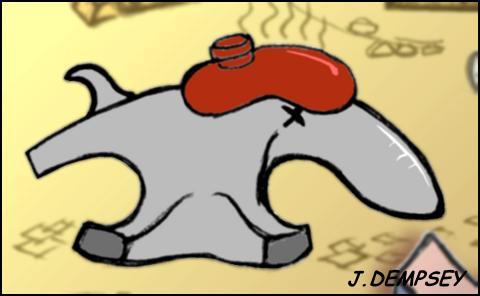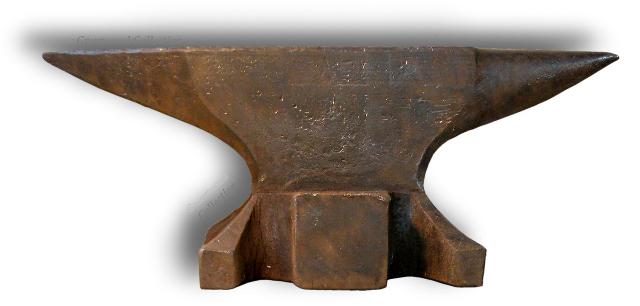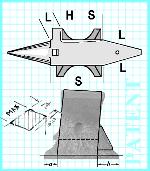Normally the horns on all well designed anvils with soft iron (wrought or low carbon steel) horns slope upwards about the amount of the step in a straight line from the step to the tip of the horn. This is so that during the life of the anvil the pounding on the horn that would make it sag, first goes from up slope (new), to level, then to down slope (old tired). This increases the visual life of the anvil.
A down slope doesn't hurt mechanically but to the human eye that equates health, youth and vigor with erect anatomical parts an upward slope or even level horn looks better than one that slopes downward or droops.

The anvil is just one of many mechanical things that man has imbued with anthropomorphism. The "face" and "hands" of a clock, "jaws" of a vise or pliers, the "eyes, nose and mouth" grill of many automobiles and trucks.
Humanoid robots are the ultimate in anthropomorphism.
An anvil has a face, heel, body, waist and feet as well as biological symmetry.
The horn which developed over time to a stylized yet organic looking rhinoceros horn is often considered a phallic device as in "mine's bigger than yours", but could also be recognizably albeit distrotedly female (From a Western point of view. See African fertility sculpture for another viewpoint).

Modern all-steel anvils have less trouble with sag than the old wrought anvils and many today are made with the horn level, especially when there is no step. The exception is those designed by connoisseurs of anvil design that understand these details even if they have not analyzed the art or psychology of anthropomorphism.
Jock Dempsey, Guru's Den 02/18/09. Photos from Scott Smith and Josh Greenwood. Cartoon clip from "After Party Anvils" by Jock Dempsey







Normally the horns on all well designed anvils with soft iron (wrought or low carbon steel) horns slope upwards about the amount of the step in a straight line from the step to the tip of the horn. This is so that during the life of the anvil the pounding on the horn that would make it sag, first goes from up slope (new), to level, then to down slope (old tired). This increases the visual life of the anvil. A down slope doesn't hurt mechanically but to the human eye that equates health, youth and vigor with erect anatomical parts an upward slope or even level horn looks better than one that slopes downward or droops.
The anvil is just one of many mechanical things that man has imbued with anthropomorphism. The "face" and "hands" of a clock, "jaws" of a vise or pliers, the "eyes, nose and mouth" grill of many automobiles and trucks. Humanoid robots are the ultimate in anthropomorphism. An anvil has a face, heel, body, waist and feet as well as biological symmetry. The horn which developed over time to a stylized yet organic looking rhinoceros horn is often considered a phallic device as in "mine's bigger than yours", but could also be recognizably albeit distrotedly female (From a Western point of view. See African fertility sculpture for another viewpoint).
Modern all-steel anvils have less trouble with sag than the old wrought anvils and many today are made with the horn level, especially when there is no step. The exception is those designed by connoisseurs of anvil design that understand these details even if they have not analyzed the art or psychology of anthropomorphism.
Jock Dempsey, Guru's Den 02/18/09. Photos from Scott Smith and Josh Greenwood. Cartoon clip from "After Party Anvils" by Jock Dempsey